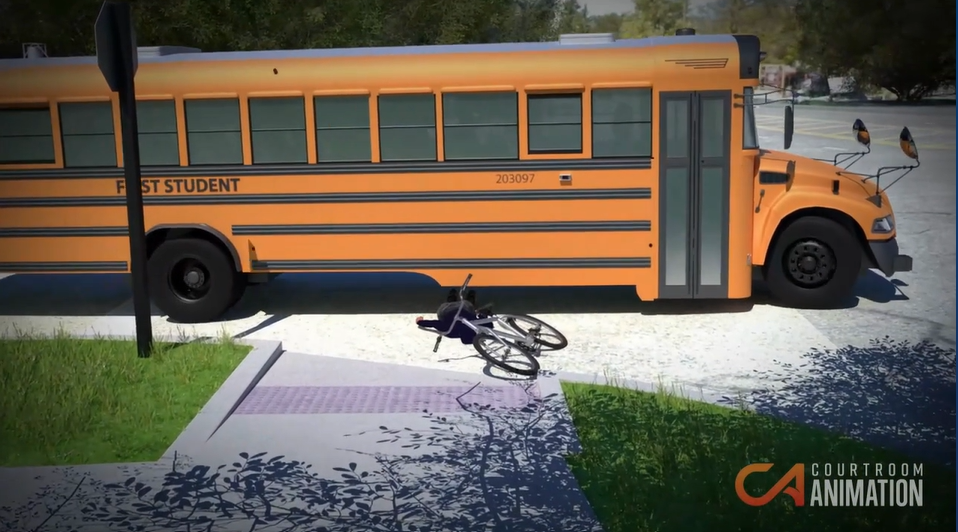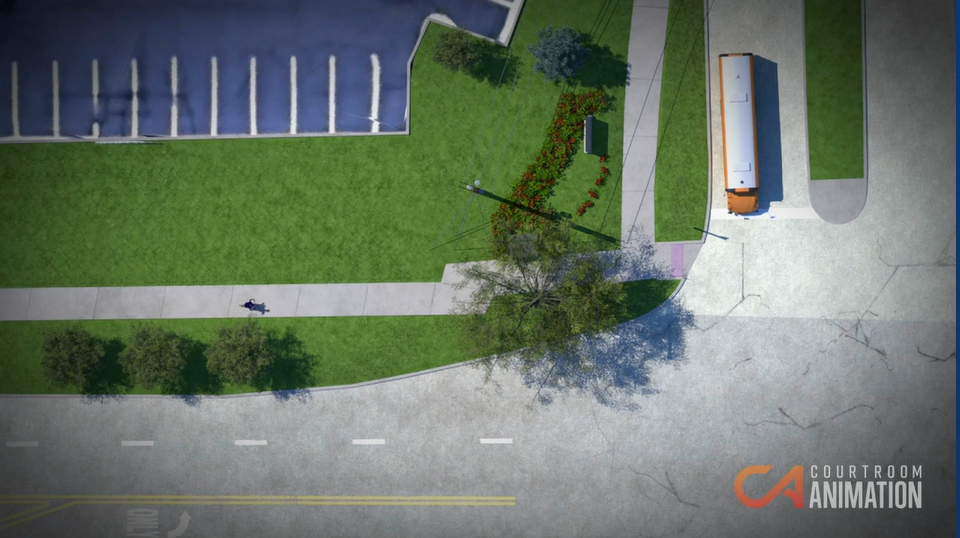Summary:
In Chicago, a cyclist was riding down a sidewalk and noticed a school bus pulling up to the stop sign. The cyclist did not slow down or operate his bike safely, which resulted in a hard stop that pitched him over the handlebars. Unfortunately, he was run over by the rear tires of the school bus as the unknowing driver made a right turn.
The cyclist, who was the plaintiff in this case, sued the school bus company for liability. Courtroom Animation was retained by the defense counsel, and created four demonstrative evidence animations for mediation discussions. The case closed with a favorable defense settlement.
“The animations were a great visual aid during mediation to show the actions taken by the cyclist. It was vital for settling favorably and avoiding trial.”
– Tom Soule, Attorney at Patton Ryan LLC
Challenge: Conveying the Ample Time to Make a Decision
The plaintiff’s deposition stated that the bus driver blocked his path, and that was the reasoning behind him slamming on his brakes and falling under the bus.
To neutralize this argument, it was important to visually represent that he had multiple opportunities to brake or change direction. This was crucial in reducing the demanded settlement amount for the defense’s client.

How could the defense counsel explain the nuance in the accident’s timing and stay away from conjecture? Demonstrative evidence, in the form of accident recreation animations, proved to be one of the best courses of action.
Solution: Four Demonstrative Evidence Visuals of the Incident
The most essential part of the data visualization’s success was depicting the timing of the incident. To best support the defense counsel, the legal animations needed to visually connect the dots on how the cyclist had plenty of time to change his pace, hit the brakes, or see what was happening.

To ensure accuracy, our forensic animation team worked with an accident reconstruction expert. They provided data from simulations and from the bus’ blackbox, which communicated the positioning and speeds of the cyclist and the bus.
There were four animations in total, two birds eye-views and the plaintiff’s view, and one version of each had a timer that depicted how long the plaintiff had to slow down.
Creating these animations with this physical data and with depositions from the experts reinforced the bus driver’s defense that the plaintiff had plenty of time to see the bus.

The visuals depicted the plaintiff first noticing the bus when he was at the Chevy Chase sign at the beginning of the video, which was almost 16 seconds until the final impact. The plaintiff himself referenced this positioning in his own deposition.
In those long sixteen seconds, he rode the bike at a high speed, stood up on the bike, and did not change his course. The data reflects how the cyclist reached the minimum point in time where someone would need to break to not hit the bus and stop on the sidewalk at the speed he’s traveling, and he consciously misses it.
Results:
The defense attorney introduced the animations as demonstrative evidence, and after reviewing the visuals with the mediator and the opposing counsel, received a favorable settlement for his client.
Interested in seeing more demonstrative evidence examples and how they can impact your defense case? Schedule a consultation based on your litigation needs today!